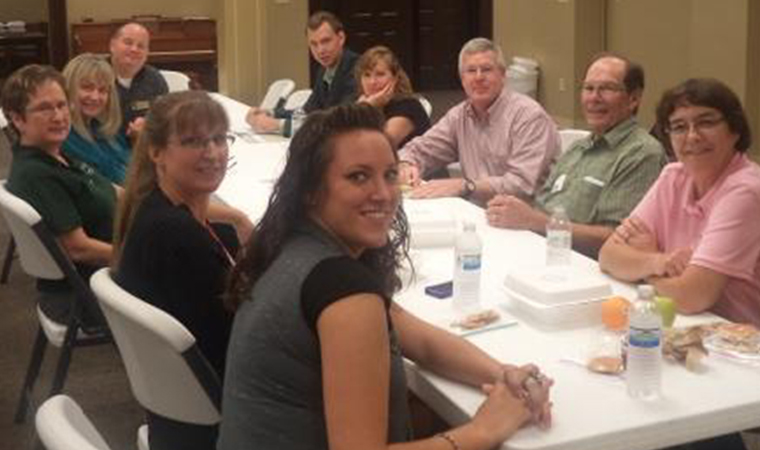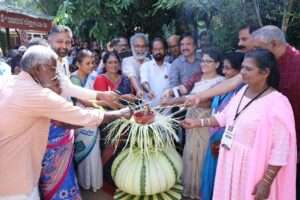 Fostering entrepreneurship development among rural youth is emerging as an important theme to be addressed by extension. The recent conference on
Fostering entrepreneurship development among rural youth is emerging as an important theme to be addressed by extension. The recent conference on
“Connecting Entrepreneurial Community” held at Marshall, Michigan in USA discussed ways of promoting entrepreneurship and led to sharing of innovative resources, information and tools to do this. Dr. R. Venkattakumar, Principal Scientist, National Academy of Agricultural Research Management (NAARM), India reflects on his participation in this conference.
Being an international scholar sponsored by the National Agricultural Innovation Programme (NAIP)
at the World Technology Access Programme (WorldTAP),
Institute of International Agriculture,
Michigan State University (MSU) on ‘Policy for Promoting Entrepreneurship in Agriculture’, I had an
opportunity to participate in this conference (Box 1).
Box 1: Connecting Entrepreneurial Community
This conference was a statewide gathering of community movers, organizations, and businesses focused on growing and sustaining entrepreneurial cities, towns, and regions that attract youthful talent and ideas in and to Michigan. Its objectives were to: generate excitement about the role of entrepreneurs in growing resilient communities, share innovative resources, information and tools, strengthen regional capacity and support for entrepreneurs and build clusters of communities that are passionate about entrepreneurship and prepared to act. Apart from two key note speeches at the beginning and end of the conference, there were 21 breakout sessions. There were about 75 participants. The participants were given opportunity to select 5 sessions of their choice to participate, interact, deliberate and plan for their future. The breakout sessions were categorized into 4 different groups of entrepreneurship promotion themes as follows: Overview of entrepreneurship promotion, Enterprise-based promotional strategies, Support services for entrepreneurship and ICTs and Entrepreneurship.
WHAT I LEARNT
1. The Cardinal Rules of Business
The key note address by Hans Schuler, Schuler’s Restaurant and Pub gave a lot of pragmatic tips for the entrepreneurs. The first and foremost rule in entrepreneurship is that ‘if you don’t like, then you get out’. Though this is a very hard rule to follow, if followed, ‘it rewards’. ‘The way we communicate’ is very important in general, while ‘continuously evolving’ is important for success. The business players and the entrepreneurs need to recognize the policies related to their business and appreciate the resources available with them and then move-on through appropriate collaboration in the competitive business world. Valuing and understanding customers, creating and consistently adopting unique business values and ethics, having ability to feel the pulse of the market, hiring smart and managing hard, taking care of employees are the important rules to be followed. ‘Don’t keep all your eggs in the same basket’, ‘take one risk at time’ and ‘creativity is good but not in risk’ etc. are worth tips in practicing business.
2. It’s all about the Money–Sources of Capital for Entrepreneurs
Ms. Lori J Meeder, Senior Lender from Northern Initiatives spoke on financial avenues and opportunities for US entrepreneurs. Traditional lending banks coaches in accessing finance, provide risk averse through in-the-box thinking and efficiency-driven lending and follows centralized decision making. There are many government schemes for supporting finance for rural entrepreneurship (www.sba.gov.) like that of support from USDA. These schemes have links through major banking systems. There are also revolving funds schemes for the entrepreneurs from federal government, however lack link with banking system and hence considered as risky. Many micro-lenders operate as the community-based non-profit operators. Angel investors do support entrepreneurs in the early stage by being impressed by the concept or innovations of the entrepreneurs but assume inboard advisory roles. In general, their stake in supporting entrepreneurship is high. Venture capitalists support for further development of established businesses for growth with pre-stated exit plan towards uncertainties and failures. There are also some innovative sources for financing entrepreneurial community emerging such as ‘Start Gardens’ (http://startgarden.com.) that promotes start-up businesses and ‘Crowd Funding’ an arrangement that tries to pool different sources of business finances.
3. Build your Business with Social Media
Ms. Candy Jones of Web World Advantage (www.webworldadvantage.net) spoke on opportunities to build on business ventures through social media. Recent studies have showed that email is the # 1 way of communicating socially. This may be a very good tool for online marketing campaign. There are many tools in use as well emerging for online marketing. Face book is great for people who like your brand and want to interact with you personally. The brand exposure through Face book is excellent. Twitter gives great website integration and helps to monitor what people feel about your product and that of your competitors. LinkedIn is good for personal branding and connecting as well as demonstrating your professionalism. Googlet has the ability to segment your market reach through circles. For businesses with a storefront, integration with Googlet may a bonus. Pinterest can be very effective in driving traffic to your business website, great for brand awareness creation and building brand story through images. You tube is one of the most powerful branding tools on the web with Google interactions. It is a great way to link back to your website because video visibility ranks so high. WordPress is a great way to create a blog/ website that you can control and an easy way to link back traffic to your website. Through WordPress you can update your website from anywhere on any device. Stumbleupon enables a diverse group of customers to find your website/ page. Proper page labeling can give you a boost to the top page and works best in conjunction with your blog. Capacity building of entrepreneurs in use of such social media definitely has significant impact in promoting entrepreneurship.
Extension educators/ innovation counselors who organized the event from behind
4. Creating the Next Generation of Entrepreneurs
A representative from Generation E Institute (www.genei.org) that builds the capacity of youth in various entrepreneurship arenas spoke on mentoring youth towards entrepreneurship. Young people need opportunity to continue to live in their community. Such opportunity can be given through appropriate entrepreneurship education, through establishing a supportive community environment and through mentoring youth towards their entrepreneurial interests. Mentoring rural youth to connect them to entrepreneurial pathway is very important to provide a reason to stay at rural areas. Such mentoring may be given through opportunity to practice their innovation and ideas at a limited scale in the initial stage, then providing necessary education to guide them in required pathways and facilitating them to expand their business by providing necessary support services. This approach followed by Generation E Institute needs community appraisal to assess the opportunities, community engagement to identify the interested youth pockets, community planning, community training for youth and finally community assistance for sustainability towards youth entrepreneurship. Similar approach may be followed in India by Institutes that promote rural entrepreneurship.
5. Web-Based Tools to Help Entrepreneurs
Ms. Laura Lewitt, MSU Business Library, MSU, spoke on web-based support services available for entrepreneurs. MSU Library designed an online ‘Business Model Generator’
(http://businessmodelgenerator.com) for the use of entrepreneurs. This supports the start-up entrepreneurs who are with business ideas and concepts to plan their business models. This business model canvas has nine blocks for business planning such as key partners, key activities, key resources, value propositions, customer relationship, customer segments, channels, cost structure and revenue streams at which the entrepreneurs can prepare their business plan. The MSU library (Willium C Gast Business Library: www.lib.msu.edu) also has many on-line resources such as MINTEL,
IBIS World Industry Report, New Strategist Titles, Demographics Now etc. to facilitate the entrepreneurs to support their business activities. The library also has set up a marketing blog to help the start-ups to find their initial markets (www.startupmarketing.com). The MSU Business Library Model is worth emulating by SAUs in India.
6. Helping entrepreneurs to move next leg of their journey
Mr. Tom Erhart, Northern Lakes Economic Alliance (NLEA) (www.northerlakes.net) spoke about the entrepreneurship support services available with NLEA. NLEA is a non-profit organization that provides financing support for business proposals through partnership agreements in terms of accounting system set-up, website development, marketing materials, legal issues and business growth projects. NLEA also provides assistance for business consulting, connecting with professional service resources, website analysis, strategic business planning, market research and connecting to financial resources. It organizes quarterly educational programmes for CEOs and Executives of growth companies. The assistance and support by such organizations are very essential for entrepreneurial growth in a community. Presence of many such non-profit organizations is needed very much in India to promote entrepreneurship, especially in agriculture.
FINAL IMPRESSIONS
- To me, the conference agenda and objectives were novel and exciting. It was a conference organized for promoting entrepreneurship with support from the community that supposed to realize and appreciate the significance of establishing, sustaining and enhancing congenial environment for entrepreneurship and business promotion. In that way, this approach provided the platform for the business operators, entrepreneurs, promoters, financiers and the end users to meet and discuss concerns and new proposals and initiate collaboration and partnerships. This concept itself is worth emulating in South Asia especially in agriculture which is a primary source of livelihood for large sections of the population.
- Though the programme was majorly sponsored by Educational institutes like MSU, Generation E
Institute, it was completely administered by Business organizations such as Micro-enterprise Network of Michigan (MNM), Marshall Area Chamber of Commerce and Marshall Area Economic Development Alliance. Those who actually do business for the betterment of community were involved in sensitizing the community from whom they need support. This approach I feel added a lot of pragmatism to the conference proceedings.
- All the breakout sessions were conducted at business venues. With break-out sessions were embedded in shops, shopping centers, restaurants etc. throughout the downtown, the conference offered the unique opportunity to not only learn about, but experience an entrepreneurial expertise of Marshall town, the resources, available talents and strengths. Before the start of each session, the owner of the business center was given an opportunity to talk about his business and the way in which his community supports and promotes his business and also how his business supports his community.
- All the speakers were the actual practitioners. All the speakers were practitioners – owning an enterprise or business, extending business finance, extending legal consultancy, advertising, media relations and campaigning, promoting entrepreneurial community etc. No academicians or researchers spoke about business or entrepreneurial promotion. Thus there was no room for dreary sessions.
- There was no formal inauguration and valedictory sessions. There was an environment created at which the stakeholders of the conference shared their views and planned their-own future plans for collaboration or partnerships. Most importantly, there was no formal vote-of-thanks session. All the sponsors, promoters, organizers, speakers (both key note and session speakers) were, in fact, thanked at the beginning of the conference in a single sentence.
Campus-based extension educators of MSU were trained as innovation counselors to provide the business-centered services in the rural community, who are strategically positioned around Michigan State. They are part of the Venture Development program of the MSU Product Centre. They are certified to assess the developmental phase of entrepreneurial projects, identify markets, innovations and new products, help entrepreneurs make critical go/no-go decisions, and guide them from concept to launch. These extension educators or the innovation counselors were the humanforce behind organizing this conference as well as such conferences all over the domain states of MSU. This model of utilizing extension educators as innovation counselors is worth emulating in order to foster entrepreneurship in agriculture.





Add Comment